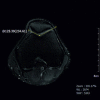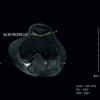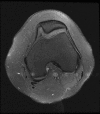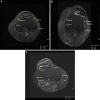Patellar malalignment: a new method on knee MRI
- PMID: 27652073
- PMCID: PMC5014770
- DOI: 10.1186/s40064-016-3195-0
Patellar malalignment: a new method on knee MRI
Abstract
Purpose: The medial patellofemoral ligament (MPFLL)/lateral patellar retinaculum (LPR) ratio were assessed in knees as a means to detect patellar malalignment. We also aimed to evaluate the prevalence of the various types of trochlear dysplasia in patients with patellar malalignment.
Materials and methods: After approval of our institutional ethics committee, we conducted a retrospective study that included 450 consecutive patients to evaluate them for the presence of patellar malalignment. Parameters investigated were the trochlear type, sulcus angle, presence of a supratrochlear spur, MPFLL, LPR, patella alta, and patella baja by means of 1.5T magnetic resonance imaging (MRI). Overall, 133 patients were excluded because of the presence of major trauma, multiple ligament injuries, bipartite patella, and/or previous knee surgery. The Dejour classification was used to assess trochlear dysplasia. Two experienced radiologists (HKY, EEE) evaluated the images. Their concordance was assessed using the kappa (κ) test.
Results: The frequencies of patellar malalignment and trochlear dysplasia were 34.7 and 63.7 %, respectively. The frequency of trochlear dysplasia associated with patellar malalignment was 97.2 %. An MPFLL/LPR ratio of 1.033-1.041 had high sensitivity and specificity for malalignment. The researchers' concordance was good (κ = 0.89, SE = 0.034, P < 0.001).
Conclusion: Trochlear dysplasia is frequently associated with patellar malalignment. An increased MPFLL/LPR ratio is useful for detecting patellar malalignment on knee MRI, which is a novel quantitative method based on ligament length.
Keywords: Knee MRI; Medial patellofemoral ligament; Patella alta- MPFLL/LPR; Trochlear dysplasia.
Figures






Similar articles
-
Identifying Patients With Patella Alta and/or Severe Trochlear Dysplasia Through the Presence of Patellar Apprehension in Higher Degrees of Flexion.Orthop J Sports Med. 2020 Jun 1;8(6):2325967120925486. doi: 10.1177/2325967120925486. eCollection 2020 Jun. Orthop J Sports Med. 2020. PMID: 32528996 Free PMC article.
-
Assessing Femoral Trochlear Morphologic Features on Cross-Sectional Imaging Before Trochleoplasty: Dejour Classification Versus Quantitative Measurement.AJR Am J Roentgenol. 2020 Aug;215(2):458-464. doi: 10.2214/AJR.19.22400. Epub 2020 Jun 6. AJR Am J Roentgenol. 2020. PMID: 32507014
-
Association between patellar cartilage defects and patellofemoral geometry: a matched-pair MRI comparison of patients with and without isolated patellar cartilage defects.Knee Surg Sports Traumatol Arthrosc. 2016 Mar;24(3):838-46. doi: 10.1007/s00167-014-3385-7. Epub 2014 Oct 30. Knee Surg Sports Traumatol Arthrosc. 2016. PMID: 25354557
-
Knee morphology and patella malalignment in neglected developmental dysplasia of the hip: a systematic review and meta-analysis.J Orthop Surg Res. 2025 May 20;20(1):489. doi: 10.1186/s13018-025-05877-y. J Orthop Surg Res. 2025. PMID: 40394669 Free PMC article.
-
Guidelines for medial patellofemoral ligament reconstruction in chronic lateral patellar instability.J Am Acad Orthop Surg. 2014 Mar;22(3):175-82. doi: 10.5435/JAAOS-22-03-175. J Am Acad Orthop Surg. 2014. PMID: 24603827 Review.
Cited by
-
Inconsistent repeatability of the Dejour classification of trochlear dysplasia due to the variability of imaging modalities: a systematic review.Knee Surg Sports Traumatol Arthrosc. 2023 Dec;31(12):5707-5720. doi: 10.1007/s00167-023-07612-8. Epub 2023 Nov 2. Knee Surg Sports Traumatol Arthrosc. 2023. PMID: 37919443
-
Radiomics-based diagnosis of patellar chondromalacia using sagittal T2-weighted images.Radiologie (Heidelb). 2025 Jan 21. doi: 10.1007/s00117-024-01413-x. Online ahead of print. Radiologie (Heidelb). 2025. PMID: 39836176 English.
-
The quadriceps active ratio: a dynamic MRI-based assessment of patellar height.Eur J Orthop Surg Traumatol. 2018 Aug;28(6):1165-1174. doi: 10.1007/s00590-018-2170-6. Epub 2018 Mar 15. Eur J Orthop Surg Traumatol. 2018. PMID: 29546510
References
LinkOut - more resources
Full Text Sources
Other Literature Sources

